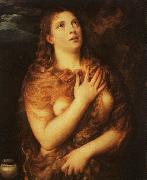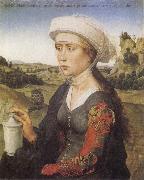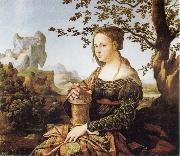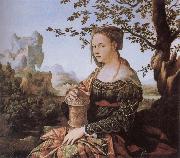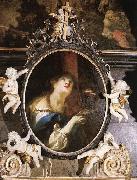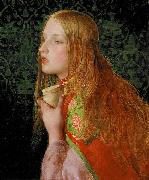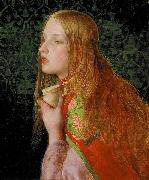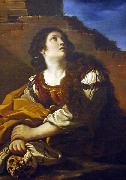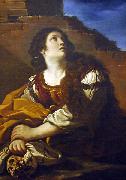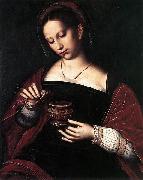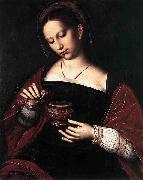Wholesale Oil Painting No Minimum |
|||||||||||
|
|
|||||||||||

|
|||||||||||
|
|
|
||||||||
|
|
||||||||
Mary Magdalene
Mary Magdalene Painting ID:: 1696 |
1533
Pitti Palace, Florence 1533 Pitti Palace, Florence |
|||||||
|
|
||||||||
Piero della FrancescaItalian Early Renaissance Painter, ca.1422-1492 Italian painter and theorist. His work is the embodiment of rational, calm, monumental painting in the Italian Early Renaissance, an age in which art and science were indissolubly linked through the writings of Leon Battista Alberti. Born two generations before Leonardo da Vinci, Piero was similarly interested in the scientific application of the recently discovered rules of perspective to narrative or devotional painting, especially in fresco, of which he was an imaginative master; and although he was less universally creative than Leonardo and worked in an earlier idiom, he was equally keen to experiment with painting technique. Piero was as adept at resolving problems in Euclid, whose modern rediscovery is largely due to him, as he was at creating serene, memorable figures, whose gestures are as telling and spare as those in the frescoes of Giotto or Masaccio. His tactile, gravely convincing figures are also indebted to the sculpture of Donatello, an equally attentive observer of Classical antiquity. In his best works, such as the frescoes in the Bacci Chapel in S Francesco, Arezzo, there is an ideal balance between his serene, classical compositions and the figures that inhabit them, the whole depicted in a distinctive and economical language. In his autograph works Piero was a perfectionist, creating precise, logical and light-filled images (although analysis of their perspective schemes shows that these were always subordinated to narrative effect). However, he often delegated important passages of works (e.g. the Arezzo frescoes) to an ordinary, even incompetent, assistant. |
||||||||
|
|
||||||||
|
|
Mary Magdalene
Mary Magdalene Painting ID:: 33265 |
mk83
c.1468
Fresco
190x180cm
mk83 c.1468 Fresco 190x180cm |
||||||
|
|
||||||||
Roger Van Der Weydenc.1399-1464 Rogier van der Weyden was the son of Henri de le Pasture, a cutler in Tournai, and Agn?s de Watreloz. His birthdate is estimated from the facts that he was stated to be 35 in April 1435 and 43 in September 1441. Before or in 1427 he married Elisabeth Goffaert (c. 1405-77), whose father was a prosperous shoemaker in Brussels. Rogier may have lived for a time in Brussels: his eldest child Cornelis (b 1427) was sometimes referred to as 'de Bruxella' but was not necessarily a native of Brussels. On 5 March 1427 'Rogelet de le Pasture, natif de Tournai' was apprenticed to the Tournai painter Robert Campin. This Rogelet duly completed his apprenticeship in 1431 and on 1 August 1432 became a master of the Tournai guild. Despite much debate, it would appear that Rogelet was Rogier van der Weyden, though it has also been argued that in 1427 Rogier was a married man well past the normal age of apprenticeship and that Rogelet must have been a second Tournai painter of the same name. JACQUES DARET, however, was in his twenties when in 1428 he was apprenticed to Campin, and other instances can be cited of married apprentices. The political situation at Tournai in 1427-8 was unusual, and the guild system was not functioning normally. |
||||||||
|
|
||||||||
|
|
Mary Magdalene
Mary Magdalene Painting ID:: 33431 |
mk86
c.1453
Oil on wood
41x34cm
Paris,Musee National du Louvre
mk86 c.1453 Oil on wood 41x34cm Paris,Musee National du Louvre |
||||||
|
|
||||||||
Jan van ScorelDutch 1495-1562 Jan Van Scorel Galleries Jan van Scorel (1495, Schoorl - December 6, 1562, Utrecht) was an influential Dutch painter credited with the introduction of High Italian Renaissance art to the Netherlands. It is not known whether he began his studies under Jan Gossaert in Utrecht or with Jacob Cornelisz in Amsterdam, but it certain that it was the master painters he would meet later in his life who would have the greatest effect on his technique. Van Scorel began traveling through Europe in his early twenties, first heading to Nuremberg and then to Austria. It was there, in 1520, that he completed his first representative work, the "Sippenaltar" in St. Martin's church in the village of Obervellach. Giorgione served as a considerable influence on van Scorel during a tenure in Venice. Upon leaving Venice, van Scorel passed through Rome and made a pilgrimage to the Holy Land. His experiences in Jerusalem are depicted in many of his later works. In 1521, van Scorel returned to Rome where he met Pope Adrian VI, who appointed him painter to the Vatican. He himself sat for a portrait. Van Scorel enjoyed the influence of Michelangelo and Raphael, and succeeded Raphael as Keeper of the Belvedere. Upon his return to the Netherlands in 1524, he settled in Haarlem where he began a successful career as a painter and a teacher. Van Scorel was a very educated man and skilled as an engineer and an architect, as well as an artist. He was also multi-lingual, no doubt as a result of his travels. Considered to be the leading Netherlandish Romanist, van Scorel moved to Ghent for painting contracts before moving to Utrecht for the same reason, where he died in 1562, leaving behind a wealth of portraits and altarpieces. Though many of his works fell victim to the Iconoclasm in 1566, some still remain and can be seen primarily at museums in the Netherlands. |
||||||||
|
|
||||||||
|
|
Mary Magdalene
Mary Magdalene Painting ID:: 33539 |
mk86
1529
Oil on canvas
67x76.5cm
Asmsterdam,Rijksmuseum
mk86 1529 Oil on canvas 67x76.5cm Asmsterdam,Rijksmuseum |
||||||
|
|
||||||||
Jan van ScorelDutch 1495-1562 Jan Van Scorel Galleries Jan van Scorel (1495, Schoorl - December 6, 1562, Utrecht) was an influential Dutch painter credited with the introduction of High Italian Renaissance art to the Netherlands. It is not known whether he began his studies under Jan Gossaert in Utrecht or with Jacob Cornelisz in Amsterdam, but it certain that it was the master painters he would meet later in his life who would have the greatest effect on his technique. Van Scorel began traveling through Europe in his early twenties, first heading to Nuremberg and then to Austria. It was there, in 1520, that he completed his first representative work, the "Sippenaltar" in St. Martin's church in the village of Obervellach. Giorgione served as a considerable influence on van Scorel during a tenure in Venice. Upon leaving Venice, van Scorel passed through Rome and made a pilgrimage to the Holy Land. His experiences in Jerusalem are depicted in many of his later works. In 1521, van Scorel returned to Rome where he met Pope Adrian VI, who appointed him painter to the Vatican. He himself sat for a portrait. Van Scorel enjoyed the influence of Michelangelo and Raphael, and succeeded Raphael as Keeper of the Belvedere. Upon his return to the Netherlands in 1524, he settled in Haarlem where he began a successful career as a painter and a teacher. Van Scorel was a very educated man and skilled as an engineer and an architect, as well as an artist. He was also multi-lingual, no doubt as a result of his travels. Considered to be the leading Netherlandish Romanist, van Scorel moved to Ghent for painting contracts before moving to Utrecht for the same reason, where he died in 1562, leaving behind a wealth of portraits and altarpieces. Though many of his works fell victim to the Iconoclasm in 1566, some still remain and can be seen primarily at museums in the Netherlands. |
||||||||
|
|
||||||||
|
|
Mary Magdalene
Mary Magdalene Painting ID:: 40350 |
mk156
c.1530
Oil on panel
67x76.5cm
mk156 c.1530 Oil on panel 67x76.5cm |
||||||
|
|
||||||||
TINTORETTO, JacopoBirth Year:, 1518. Death Year:, 1594 |
||||||||
|
|
||||||||
|
|
Mary Magdalene
Mary Magdalene Painting ID:: 41144 |
mk157
1583-87
Oil on canvas
425x209cm
mk157 1583-87 Oil on canvas 425x209cm |
||||||
|
|
||||||||
BENSON, AmbrosiusFlemish Northern Renaissance Painter, ca.1495-1550 South Netherlandish painter of Italian birth. In 1518 he acquired Bruges citizenship, and in 1519 he was admitted to the guild of painters and saddlemakers there as an independent master, with the comment that he was 'from Lombardy'. He may have been from Ferrara, although he was originally called Ambrogio Benzone, taking his first name from the patron saint of Milan, the capital of Lombardy. He was probably attracted to Bruges by its commercial and artistic reputation. Initially he worked in the studio of Gerard David, by whom he was profoundly influenced, but after a few months the relationship went wrong and the younger painter brought a case against David. Benson's first marriage was to Anna Ghyselin, who bore him two sons, Willem Benson (1521/2-1574) and Jan Benson (before 1530-before 1581), both of whom became artists. From his second marriage, to Josyne Michiels, a daughter Anna was born, and he had two other daughters from various extra-marital relationships. Benson was an affluent and successful man: he owned several houses, for one of which he gave eight paintings in half payment (which gives some idea of the value of his works at the time). Benson twice received commissions from city magistrates to decorate their new county hall and was a member of the city council on three occasions; he also held important offices within the painters' guild, including dean (1537-8 and 1543-4) and governor (1540-41). His pupils included his two sons, and Joachim Spaers (1541) and Jacob Vinson (Fynson; 1549). |
||||||||
|
|
||||||||
|
|
Mary Magdalene
Mary Magdalene Painting ID:: 43840 |
Oil on oak panel,
69,5 x 55,5 cm Oil on oak panel, 69,5 x 55,5 cm |
||||||
|
|
||||||||
MAULBERTSCH, Franz AntonAustrian Painter, 1724-1796 Austrian painter. His work as a painter of both oil paintings and frescoes on religious, mythological and occasionally worldly themes spanned the second half of the 18th century, adapting a Late Baroque training to the onset of Neo-classicism but remaining strikingly individual throughout. His fresco work, mostly still in situ in widespread central European locations, came at the end of an artistic tradition and was for long neglected, being far from major cultural centres; but it is now seen to establish him as one of the leading painters of his century |
||||||||
|
|
||||||||
|
|
Mary Magdalene
Mary Magdalene Painting ID:: 63081 |
1754 Oil on canvas Cistertian Church, Zirc The picture shows the influence Piazzetta's painting. Artist: MAULBERTSCH, Franz Anton Painting Title: Mary Magdalen , 1751-1800 Painting Style: Austrian , , religious 1754 Oil on canvas Cistertian Church, Zirc The picture shows the influence Piazzetta's painting. Artist: MAULBERTSCH, Franz Anton Painting Title: Mary Magdalen , 1751-1800 Painting Style: Austrian , , religious |
||||||
|
|
||||||||
Anthony Frederick Augustus Sandys1829-1904 English painter, illustrator and draughtsman. He was the son of Anthony Sands (1804-83), a minor local artist. He began his artistic education with his father and attended the Norwich School of Design from 1846. His precocious talent was recognized by the award of silver medals by the Society of Arts in 1846 and 1847. He moved to London in 1851, when he first exhibited at the Royal Academy, but he continued to spend time at Norwich until the death of his parents in 1883. After publishing in 1857 A Nightmare, a gentle caricature of John Ruskin and his Pre-Raphaelite prot?g?s William Holman Hunt, John Everett Millais and Dante Gabriel Rossetti and based on Millais's Sir Isumbras at the Ford (Port Sunlight, Lady Lever A.G.), he met Rossetti and became a member of his circle. |
||||||||
|
|
||||||||
|
|
Mary Magdalene
Mary Magdalene Painting ID:: 75730 |
Mary Magdalene, Oil on wood panel, Samuel and Mary R. Bancroft Memorial (Delaware Art Museum)
cjr Mary Magdalene, Oil on wood panel, Samuel and Mary R. Bancroft Memorial (Delaware Art Museum) cjr |
||||||
|
|
||||||||
Anthony Frederick Augustus Sandys1829-1904 English painter, illustrator and draughtsman. He was the son of Anthony Sands (1804-83), a minor local artist. He began his artistic education with his father and attended the Norwich School of Design from 1846. His precocious talent was recognized by the award of silver medals by the Society of Arts in 1846 and 1847. He moved to London in 1851, when he first exhibited at the Royal Academy, but he continued to spend time at Norwich until the death of his parents in 1883. After publishing in 1857 A Nightmare, a gentle caricature of John Ruskin and his Pre-Raphaelite prot?g?s William Holman Hunt, John Everett Millais and Dante Gabriel Rossetti and based on Millais's Sir Isumbras at the Ford (Port Sunlight, Lady Lever A.G.), he met Rossetti and became a member of his circle. |
||||||||
|
|
||||||||
|
|
Mary Magdalene
Mary Magdalene Painting ID:: 77504 |
Oil on wood panel, Samuel and Mary R. Bancroft Memorial (Delaware Art Museum)
Deutsch: Maria Magdalena, Öl auf Holz, Samuel and Mary R. Bancroft Memorial (Delaware Art Museum)
Date c. 1858-60
cyf Oil on wood panel, Samuel and Mary R. Bancroft Memorial (Delaware Art Museum) Deutsch: Maria Magdalena, Öl auf Holz, Samuel and Mary R. Bancroft Memorial (Delaware Art Museum) Date c. 1858-60 cyf |
||||||
|
|
||||||||
GUERCINOItalian Baroque Era Painter, 1591-1666 best known as Guercino or Il Guercino, was an Italian Baroque painter from the region of Emilia, and active in Rome and Bologna. Guercino is Italian for squinter, a nickname that was given to him because he was cross-eyed. He is especially noted for his many superb drawings. Guercino was born at Cento, a village between Bologna and Ferrara. By the age of 17 he was associated with Benedetto Gennari, a painter of the Bolognese School. By 1615 he moved to Bologna, where his work earned the praise of an elder Ludovico Carracci. He painted two large canvases, Elijah Fed by Ravens and Samson Seized by Philistines, in what appears to be a stark naturalist Caravaggesque style (although it is unlikely he had been able to see any of the Roman Caravaggios first-hand). They were painted for Cardinal Serra, Papal Legate to Ferrara. The Arcadian Shepherds (Et in Arcadia ego) was painted in 1618 contemporary with The Flaying of Marsyas by Apollo in Palazzo Pitti. His first style, he often claimed, was influenced by a canvas of Carracci in Cento. Some of his later pieces approach rather to the manner of his great contemporary Guido Reni, and are painted with more lightness and clearness. Guercino was esteemed very highly in his lifetime. He was then recommended by Marchese Enzo Bentivoglio to the Bolognese Ludovisi Pope, Pope Gregory XV. His two years (1621-23) spent in Rome were very productive. From this stay date his frescoes of Aurora at the casino of the Villa Ludovisi and the ceiling in San Crisogono (1622) of San Chrysogonus in Glory; his portrait of Pope Gregory (now in the Getty Museum, and, what is considered his masterpiece, The Burial of Saint Petronilla or St. Petronilla Altarpiece, for the Vatican (now in the Museo Capitolini). The Franciscan order of Reggio in 1655 paid him 300 ducats for the altarpiece of Saint Luke Displaying a Painting of the Madonna and Child (now in Nelson-Atkins Museum of Art, Kansas City). The Corsini also paid him 300 ducats for the Flagellation of Christ painted in 1657. |
||||||||
|
|
||||||||
|
|
Mary Magdalene
Mary Magdalene Painting ID:: 79190 |
circa 1624-1625
Medium Oil on canvas
cyf circa 1624-1625 Medium Oil on canvas cyf |
||||||
|
|
||||||||
GUERCINOItalian Baroque Era Painter, 1591-1666 best known as Guercino or Il Guercino, was an Italian Baroque painter from the region of Emilia, and active in Rome and Bologna. Guercino is Italian for squinter, a nickname that was given to him because he was cross-eyed. He is especially noted for his many superb drawings. Guercino was born at Cento, a village between Bologna and Ferrara. By the age of 17 he was associated with Benedetto Gennari, a painter of the Bolognese School. By 1615 he moved to Bologna, where his work earned the praise of an elder Ludovico Carracci. He painted two large canvases, Elijah Fed by Ravens and Samson Seized by Philistines, in what appears to be a stark naturalist Caravaggesque style (although it is unlikely he had been able to see any of the Roman Caravaggios first-hand). They were painted for Cardinal Serra, Papal Legate to Ferrara. The Arcadian Shepherds (Et in Arcadia ego) was painted in 1618 contemporary with The Flaying of Marsyas by Apollo in Palazzo Pitti. His first style, he often claimed, was influenced by a canvas of Carracci in Cento. Some of his later pieces approach rather to the manner of his great contemporary Guido Reni, and are painted with more lightness and clearness. Guercino was esteemed very highly in his lifetime. He was then recommended by Marchese Enzo Bentivoglio to the Bolognese Ludovisi Pope, Pope Gregory XV. His two years (1621-23) spent in Rome were very productive. From this stay date his frescoes of Aurora at the casino of the Villa Ludovisi and the ceiling in San Crisogono (1622) of San Chrysogonus in Glory; his portrait of Pope Gregory (now in the Getty Museum, and, what is considered his masterpiece, The Burial of Saint Petronilla or St. Petronilla Altarpiece, for the Vatican (now in the Museo Capitolini). The Franciscan order of Reggio in 1655 paid him 300 ducats for the altarpiece of Saint Luke Displaying a Painting of the Madonna and Child (now in Nelson-Atkins Museum of Art, Kansas City). The Corsini also paid him 300 ducats for the Flagellation of Christ painted in 1657. |
||||||||
|
|
||||||||
|
|
Mary Magdalene
Mary Magdalene Painting ID:: 79946 |
circa 1624-1625
Medium Oil on canvas
Current location Blanton Museum of Art
cyf circa 1624-1625 Medium Oil on canvas Current location Blanton Museum of Art cyf |
||||||
|
|
||||||||
Ambrosius Benson(c.1495/1500, Ferrara or Milan - 1550, Flanders) was an Italian painter who became a part of the Northern Renaissance. While many surviving paintings have been attributed, there is very little known of him from records, and he tended not to sign his work. He is believed to be responsible for mainly religious art, but also painted portraits on commission. He sometime painted from classical sources, often setting the figures in modern-dress, or a contemporary domestic setting. In his lifetime he was successful; he had a large workshop, his work was sold internationally and he was especially popular in Spain. Benson became popular as a source for pastiche with 19th century painters, who are sometimes known as the "followers of Benson". In particular his many variations of the Magdalen and Sibilla Persica, were further copied and became popular with contemporary buyers. Many have retained their relative value and held in the National Gallery, London and command high prices at Sotheby's |
||||||||
|
|
||||||||
|
|
Mary Magdalene
Mary Magdalene Painting ID:: 85215 |
Date first half of 16th century
Medium Oil on oak panel
Dimensions Height: 69.5 cm (27.4 in). Width: 55.5 cm (21.9 in).
cjr Date first half of 16th century Medium Oil on oak panel Dimensions Height: 69.5 cm (27.4 in). Width: 55.5 cm (21.9 in). cjr |
||||||
|
|
||||||||
Ambrosius Benson(c.1495/1500, Ferrara or Milan - 1550, Flanders) was an Italian painter who became a part of the Northern Renaissance. While many surviving paintings have been attributed, there is very little known of him from records, and he tended not to sign his work. He is believed to be responsible for mainly religious art, but also painted portraits on commission. He sometime painted from classical sources, often setting the figures in modern-dress, or a contemporary domestic setting. In his lifetime he was successful; he had a large workshop, his work was sold internationally and he was especially popular in Spain. Benson became popular as a source for pastiche with 19th century painters, who are sometimes known as the "followers of Benson". In particular his many variations of the Magdalen and Sibilla Persica, were further copied and became popular with contemporary buyers. Many have retained their relative value and held in the National Gallery, London and command high prices at Sotheby's |
||||||||
|
|
||||||||
|
|
Mary Magdalene
Mary Magdalene Painting ID:: 90885 |
Oil on oak panel, 69,5 x 55,5 cm
Date 1120s
cjr Oil on oak panel, 69,5 x 55,5 cm Date 1120s cjr |
||||||
|
|
||||||||
|
Ambrosius Benson (c.1495/1500, Ferrara or Milan - 1550, Flanders) was an Italian painter who became a part of the Northern Renaissance. While many surviving paintings have been attributed, there is very little known of him from records, and he tended not to sign his work. He is believed to be responsible for mainly religious art, but also painted portraits on commission. He sometime painted from classical sources, often setting the figures in modern-dress, or a contemporary domestic setting. In his lifetime he was successful; he had a large workshop, his work was sold internationally and he was especially popular in Spain. Benson became popular as a source for pastiche with 19th century painters, who are sometimes known as the "followers of Benson". In particular his many variations of the Magdalen and Sibilla Persica, were further copied and became popular with contemporary buyers. Many have retained their relative value and held in the National Gallery, London and command high prices at Sotheby's Mary Magdalene Oil on oak panel, 69,5 x 55,5 cm Date 1120s cjr |
||||||||
|
|
||||||||
|
Prev Next
|
||||||||
|
|
||||||||
|
Related Paintings to Ambrosius Benson :. |
||||||||
|
|
||||||||
|
CONTACT US |
